We may earn commissions when you buy from links on our site. Why you can trust us.
Sonos Ace Raises the Bar for Noise-Canceling Bluetooth Headphones
If you're in the market for a new pair of active noise-canceling (ANC) over-ear headphones, there's a new player to consider: Sonos. The company, renowned for its premium mesh multi-room sound systems, has been quietly working on ANC headphones for over half a decade. Now, they're finally delivering with the introduction of the Sonos Ace.
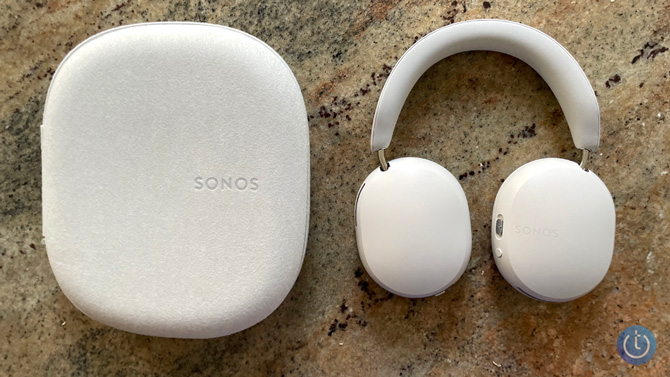
Is the Sonos Ace ($449) the new top card in the premium-grade wireless ANC headphones deck? After a week of serious listening and comparing them to the Bose QC Ultra ($429) and Sony WH-1000xm4 ($248), among others, this headphones fanatic wouldn't bet against it.
The Sonos Ace are the only headphones I’ve encountered that can decode both major forms of Spatial Audio encoded music - Dolby Atmos and Sony’s 360 Reality - and also perform a home-grown spatial processing of non-Atmos/360 material. Increasingly, you'll find your favorite tracks available in spatial audio, and you won't want to go back. Spatial audio creates more dimensionality and drama while clarifying each instrument.
The Ace likewise stands out with TV Swap, a neat trick that users can play with their Sonos Arc soundbar to shift the soundtrack from the soundbar to the headphones via a low-powered WiFi Direct wireless connection. This is great for late-night listening when you don't want to disturb housemates or neighbors. (It's also coming soon to Sonos Beam, Beam Gen 2, and Ray soundbars.)
But honestly, what really pleases me the most is the Ace's core obsession with the basics – top-flight sound and ergonomic design, which collectively deliver a "built for comfort" package that's arguably second to none. It will likely spark owners to reach for the Ace first, even over other top headphones (from the likes of Apple, Bose, and Sony) they might have in their collection.
| + Pros | – Cons | ||
|
|
||
|
|||
Audio Quality
The extra-comfy impression actually starts (and ends) with the sonic performance of the Ace – well-balanced, detailed, and neutral. Tuned by committee (in a good way), these entertainers are ripe and ready for literally any kind of music or soundtrack you throw at them, from hip hop to rock, jazz to classical. No shiny object syndrome is happening here – no "crank it up to 11" boomin' bass or excessive brightness that initially seems appealing (at, say, an in-store listening station) in other headphones but eventually induces ear fatigue and buyers' remorse. I've kept these things comfortably on my noggin for almost a full workday without fatigue setting in, with only the occasional brief time out needed to relieve the build-up of ear pressure that can happen when high compliance (40 mm) drivers are pumping in a tightly sealed space.
Design
Hitting the scales at 11.4 ounces, the Ace are not the lightest headphones on the block. Nor the most petite. Building on the boxy look of the 13.6-ounce Apple AirPod Max cans ($549) but comfier to wear, the Aces' sit nicely on my head with just the right degree of clamping, a thick surround of memory foam on the headband, and a slightly larger-than-normal and more rectangular (less oval) opening inside the memory foam-padded ear cups. Because this cup opening is wider than usual across the top and bottom (as is the foam), there is no pinching of my ears at the top and only minor overlap on my ear lobes. So, almost all of the ear tucks nicely inside a cone of foam silence.
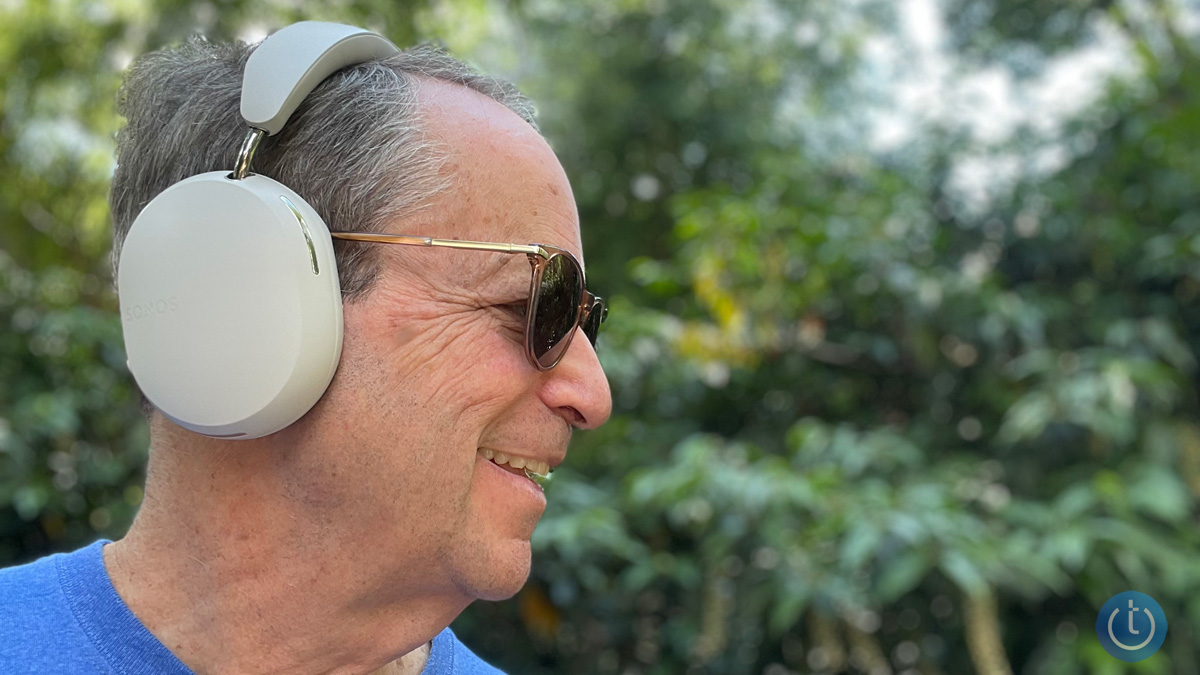
Adding to the comfort story – note the smooth, pinch-less design of the swiveling chromed metal shafts that link the headphone band and cans, with extend/retract, twist, and tension adjusters hidden inside the cups. So there's nothing exposed here to snag and tug on a wearer's long tresses. The downside? While folding flat, these cans don't also swivel inwards. So, the Ace's carry case has a slightly larger diameter than that of rivals, like the Bose QC Ultra shown below.
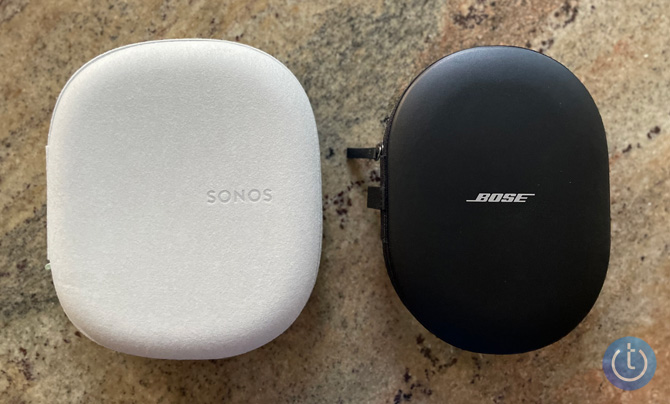
While we're on the subject, please also note the environmentally friendly nature of the Ace's case, made from recycled materials, as is the accessory pouch that clings inside (with a magnet) and holds the two cables (USB-C to USB-C and USB-C to 3.5 mm) included in the kit for plug-in audio connection, charging and AC-powered operation if you desire. The textured case material feels like hardened felt. I'm not sure how well it's going to hold up. As with the headphones themselves, there's no evidence of waterproofing. (So be careful out there. I've been carrying mine around inside a Ziploc bag.) I'd wager that Sonos will sell replacement cases and maybe take back your originals for recycling. They've already announced a swap-out strategy (though not a price) for the Ace's magnetically secured, vegan leather-wrapped earcups.
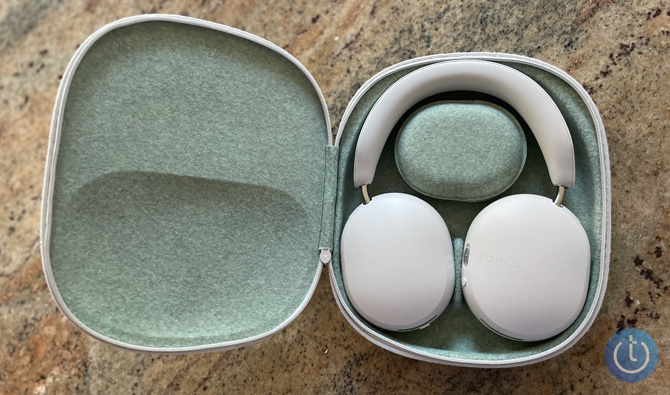
Connecting with the Sonos ecosystem
Honestly, I was hoping that the Sonos Ace would debut as a full-fledged member of the Sonos ecosystem. That didn't happen. While Ace is controllable with the same S2 app that runs Sonos speakers, it's a less versatile offspring. Sonos system devotees can't just pick music off your subscribed-to streaming services and play it straight from the network to the headphones, as is possible with all Sonos speakers.
Why would that matter? When running on WiFi, Sonos products can pull down and deliver lossless High Res FLAC encoded content at resolutions up to 24 bit/48KHz. And in theory, WiFi signals travel farther than their Bluetooth brethren – but not in testing with my Sonos Arc soundbar. The Bluetooth connection range between my iPhone 12 Pro and the Ace headphones actually proved more robust – stretching from a third-floor bedroom to a basement laundry zone (about 35 feet away, as the laundry bag flies.) The Arc to Ace WiFi radios stopped communicating when I walked 25 shoe lengths from the TV setup.
I was also hoping that streaming music selections playing straight to the Arc would be transferrable to the Ace headphones via TV Swap. More importantly, the audio would remain high-res as the connection between the Arc and Ace is made via WiFi Direct, a medium with higher data capacity than Bluetooth provides.
But none of that is happening in this first iteration of soundbar and headphones pairing. TV Swapping is only doable from external sources fed to the Arc via its HDMI or optical inputs.
As a workaround, I've called up favorite music services on my Sony Bravia XBR 48" OLED TV – SiriusXM, Radio Paradise, and Amazon Music Unlimited – and sent that content through the Arc to the Ace via the TV Swap connection. Some automatic signal down-converting (to 16 bit/48 kHz) was necessary to get new material from Little Feat and Dua Lipa playing on my Sony TV's Amazon Music app and into Sonos land. And from the Arc to the Ace, the WiFi carried signal resolution is reduced yet again, I’m told, though the music that reached my ears was still quite pleasing.
Sound processing
The Sono Ace can present lossless audio treats sent over Bluetooth from an Android-OS-based device that packs Qualcomm Snapdragon Sound aptX processing. Ace detectives might then conclude that a Qualcomm chipset – necessary to decode aptX – is aboard and likely also working on the active noise reduction and mobile phone call processing in these Sonos headphones. However, I couldn't pry that confession out of Sonos folks.
Whatever. The microprocessor is an all-around good performer. It is sufficiently efficient that you can run these headphones for 30 hours between charges with the ANC active. (Then do a fast three-minute charge to get three hours of use or charge them fully in under three hours.)
Fitted with 8 "beam focused"' microphones, the sound quality of Ace phone calls is respectable at both ends in a quiet talking zone and has decent muting of background sounds when out and about, I've been told. Sonos claims (of course) that the adaptive Active Noise Cancellation processing is "World Class." But as Qualcomm chips are packed in lots of global brand headphone products, you could take that tout two ways!
For my comparative home tests of the ANC on four different headphones, I blasted 85 dB of airplane cabin and coffee shop noises (found on Amazon Music) to my living room Move 2 speaker. Bose QC Ultra Headphones proved to be at the top of the crop and were superior at shushing these ambient noises. But the Sonos Ace were a respectable second, equal to the performance of the Sony WH-1000xm4 headphones in my arsenal, and significantly better at noise canceling than the $99 Anker Soundcore Space One, several reviewers' favorite bargain ANC headphone this season.
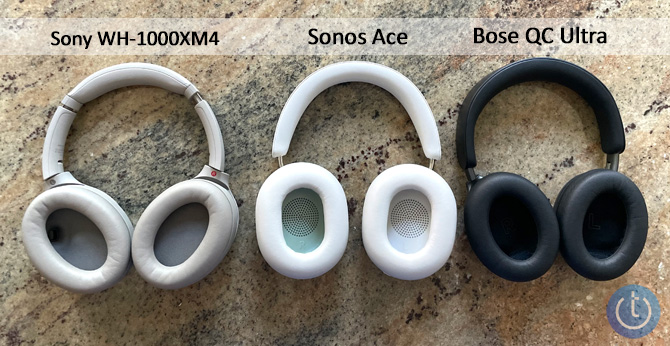
In-app and on-ear controls
Easier operation: That's another thing Sonos was aiming for with the Ace. It achieves this most successfully with the tactilely distinctive multitasking Content Key on the right earpiece. No groping or guessing is needed to find and use this raised and bumped-out tool. Tap down to start and pause the music, double or triple tap to skip tracks forward and back, and hold longer to connect/disconnect TV Swap. Sliding the key forward and back elevates or lowers the volume. Below that is a conventional round button you press and hold to activate voice assistance or tap very briefly to alternate between Active Noise Cancelling and Aware mode ( the latter drawing in and amplifying outside sounds more aggressively than I'd like.)
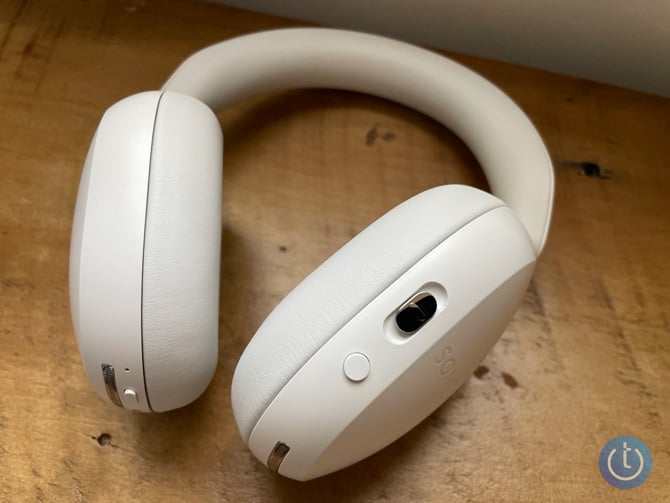
Sometimes, with just cause (to save power), the Ace headphones will disconnect from the Sonos app on your phone while maintaining their (other) Bluetooth link to your chosen streaming music app. The latter connection is sufficient for the Content Key to do its thing. But you need a live connection to the Sonos App to tweak the EQ settings and check the battery status. The "Reconnect" tab was operating erratically on the first Ace headphones Sonos sent my way. But a replacement Ace has been running flawlessly.
Other things I've discovered the hard way: To get TV Swap going, your Arc soundbar needs to be WiFi enabled. Even if your soundbar is connected to your home network via a hardwired Ethernet cable, you must also tap the "Enable WiFi" line in the Arc settings menu. Yes, both carriers can be connected simultaneously.
Read more: Sonos One vs Sonos Era 100: Should You Upgrade?
Also, if using an iOS device, make sure that its Dolby Audio output setting (found under Settings-Music-Audio- Dolby Atmos) is marked "Always On" rather than "Automatic" if you're going to be listening to spatial content from the Apple Music site. "Automatic" only triggers Apple and (sister brand) Beats headphones and earbuds to light up Atmos-coded files from Apple Music. The Ace decodes Atmos or 360 Reality content from Amazon, Tidal, Deezer, and Nugs.net, regardless of the output setting.
So how good is Spatial Audio on the Ace?
When used with a multi-speaker setup, Atmos and 360 Reality really do throw a lot of focused sound around your room in dramatic fashion. However, in headphones that have just a single 40 mm driver in each earcup, the challenge to float and even "pinpoint" sound "objects" in a virtual dome around your head is much harder. Signal phasing and timing adjustments can only do so much. Widening the apparent sound field proves to be much easier than vertically expanding it. That said, I have experienced some very interesting effects out of Ace headphones with encoded content. For example, you experience a sudden woosh of spooky depth in Kacey Musgraves' "Deeper Well" whenever she goes diving down her emotional hole. And you get a fantastic sense of spaciousness and unveiling of previously missed details in the Dolby Atmos' remix of the Beach Boys' classic "Pet Sounds" album (give a listen to "God Only Knows "and "I Just Wasn't Made For These Times").
With streaming and disc-based movies encoded in Dolby Atmos, the surround sound process does transfer from an Arc to the Ace when TV Swap is engaged, delivering some playful location shifting tricks. For other content Sonos turns on an alternate quasi-spatial scheme which is usable with or without head tracking that shifts the sound field left or right as you turn your head. As on the Bose QC Ultra headphones, which offer homegrown Spatial Audio processing (to the exclusion of Dolby Atmos or 360), some sound-spreading effects are successfully delivered, clarifying instruments and voices and adding a bit of environmental reverb. I think Bose works this magic act better, though neither rendering is earth-shattering. The Sonos version might improve when the Ace software is updated with TrueCinema processing, custom tuning the headphones to your home environment. Stay tuned.
Bottom Line
Clearly, Sonos has studied the premium wireless headphones field and found design aspects worth finessing. While I would have liked to see better integration with the Sonos ecosystem, the company got the most important things right: excellent sound quality, premium build quality, and a comfortable design. If you are shopping for a serious pair of headphones that will serve you well for years to come, the Sonos Ace ought to be on your shortlist.


[Image credit: Jonathan Takiff/Techlicious]
Jonathan Takiff is a seasoned chronicler of consumer electronics (30+ years), longtime staffer for Philadelphia newspapers, syndicated columnist and magazine/website contributor.


















